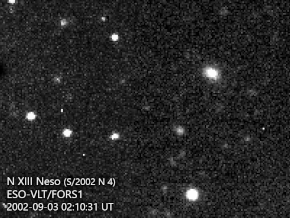Moon Neso
Neso /ˈniːsoʊ/, also known as Neptune XIII, is the second-outermost known natural satellite of Neptune, after S/2021 N 1.
It is a retrograde irregular moon discovered by Matthew J. Holman, Brett J. Gladman, et al. on 14 August 2002, though it went unnoticed until 2003. Neso is the second-most distant moon of Neptune, with an average orbital distance of over 49 million km. At its farthest point of its orbit, the satellite is more than 72 million km from Neptune. This distance exceeds Mercury's aphelion, which is approximately 70 million km from the Sun.
 Neso imaged by the Very Large Telescope's FORS1 imager in September 2002 | |
| Discovery | |
|---|---|
| Discovered by |
|
| Discovery site | Cerro Tololo Obs. |
| Discovery date | 14 August 2002 |
| Designations | |
Designation | Neptune XIII |
| Pronunciation | /ˈniːsoʊ/ |
Named after | Νησώ Nēsō |
| S/2002 N 4 | |
| Adjectives | Nesoan /nɪˈsoʊ.ən/ or Nesoian /nɪˈsoʊ.iən/ |
| Orbital characteristics | |
| Epoch 1 January 2000 (Proper orbital element) | |
| Observation arc | 19.96 yr (7,292 days) |
| 11.2° (proper) | |
| Satellite of | Neptune |
| Group | Neso group |
| Proper orbital elements | |
Proper semi-major axis | 49,598,300 km = 0.332 AU |
Proper eccentricity | 0.455 |
Proper inclination | 126.9° |
Proper mean motion | 13.4246 deg / yr |
Proper orbital period | 26.81644 yr (9794.705 d) |
Precession of the ascending node | 1161.3684 arcsec / yr |
| Physical characteristics | |
Mean diameter | 60 km (for albedo 0.04) |
| Albedo | 0.04 (assumed) |
Spectral type | V–R = 0.58±0.13 V–I = 1.0±0.4 R–I = 0.7±0.4 |
| 25.6±0.3 (V-band) | |
| 10.67 | |

Neso is also the moon with the second-longest orbital period, 26.67 years. It follows a retrograde, highly inclined, and highly eccentric orbit illustrated on the diagram in relation to other irregular satellites of Neptune. The satellites above the horizontal axis are prograde, the satellites beneath it are retrograde. The yellow segments extend from the pericentre to the apocentre, showing the eccentricity.
Neso is affected by the Kozai mechanism.
Neso is about 60 km (37 mi) in diameter based on an assumed albedo of 0.04.
Given the similarity of the orbit's parameters with Psamathe (S/2003 N 1), it was suggested that both irregular satellites could have a common origin in the break-up of a larger moon.
Neso is named after one of the Nereids. Before it was officially named on 3 February 2007 (IAUC 8802), Neso was known by its provisional designation, S/2002 N 4.
See also
References
- MPC: Natural Satellites Ephemeris Service
- Mean orbital parameters from JPL
External links
This article uses material from the Wikipedia English article Neso (moon), which is released under the Creative Commons Attribution-ShareAlike 3.0 license ("CC BY-SA 3.0"); additional terms may apply (view authors). Content is available under CC BY-SA 4.0 unless otherwise noted. Images, videos and audio are available under their respective licenses.
®Wikipedia is a registered trademark of the Wiki Foundation, Inc. Wiki English (DUHOCTRUNGQUOC.VN) is an independent company and has no affiliation with Wiki Foundation.



